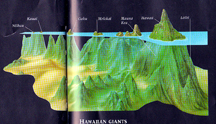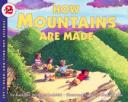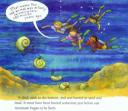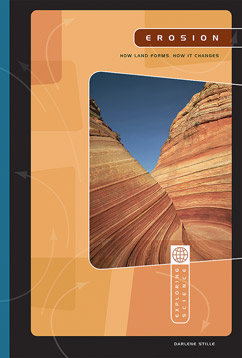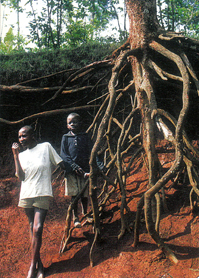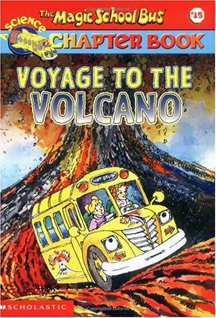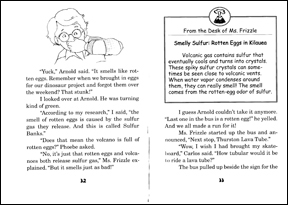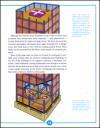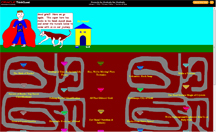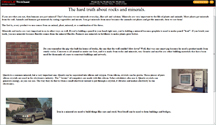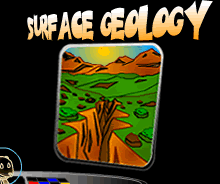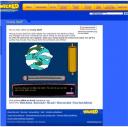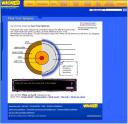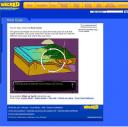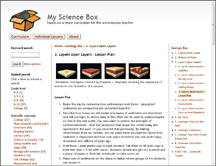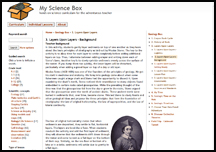Overview
The surface of our Earth in in constant flux. Its slow and ceaseless shifting can be understood by investigating snapshots of the Earth’s history through rock and fossil evidence. These pictures illuminate the story of Earth’s ever-changing ‘skin’ from the effects of volcanoes, earthquakes, weathering and erosion. Fifth grade students (VA SOL 5.7) will discover the energy deep within the Earth that powers the tectonic plates and the effect it has on life above Earth’s crust.
Books
DK Guide to Savage Earth
by Tevor Day, A Dorling Kindersley (DK) Book
DK Guides are known for their stunning photographs. This book is no exception. It is a great introduction to the Earth’s structure and plate tectonics covering such issues as Moving Continents, Volcanoes, Making Mountains, Earthquakes, Weathering and Erosion in two-page spreads of amazing photographs and illustrations. This guide provides excellent definitions of scientific concepts and pairs them with perfect visuals for the contemporary student.
How Mountains are Made, Let’s-Read-And-Find-Out Science
written by Kathleen Zoehfeld and illustrated by James Hale
The best way to describe this book is ‘kid-friendly’. It starts out like a story of four friends climbing a small mountain near their home. Once the friends find fossilized remains of sealife, the real story begins. The friends take turns explaining the science behind how the ammonite they found ended up at the top of a mountain range. The simple, yet accurate illustrations, guide the reader through the various ways mountains are formed.
Erosion: How Land Forms, How Land Changes
by Darlene Stille
This publication is beautifully designed. The pleasing layout allows this smallish book to really have an impact. It is well written and offers straightforward explanations on the erosion process with emphasis on water, wind, and glaciers. Not only does this book possess a ‘Fast Fact’ feature focusing on information bites, it also has a section on fossils and erosion, erosion on Mars, and a discussion on the appropriateness of controlling erosion. Darlene Stille has written a series of books designed like Erosion that include Plate Tectonics, Soil, Waves, and Minerals which may also prove pertinent to the Earth structure unit of study.
Voyage to the Volcano, a Magic School Bus Chapter Book
written by Judith Stamper and illustrated by John Speirs
The beloved Ms. Frizzle takes her class on a hot spot field trip to the Ring of Fire. The class teams up with a fictitious volcanologist to help them get the most out of their Kilauean tour while real life professor, Ken Rubin, from the Hawaii Center for Volcanology assisted in reviewing the text for this chapter book. Voyage to the Volcano features class notes, memos from Ms. Frizzle, and facts from the volcanologist’s files interspersed throughout the text that help clarify what the class is experiencing on their journey. Undoubtedly, this book can be a fantastic tie in with Language Arts SOLs.
Our Patchwork Planet
by Helen Sattler and Giulio Maestro
This book is a great introduction to plate tectonics and illustrates the subject well. It focuses on the drifting plates with a brief discussion on scientists’ ability to reconstruct the Earth’s history using fossil evidence. The last chapter of the book emphasizes how humans are adapting to live with the fluctuating changes of our Earth. This book is unique in that it features a couple of illustrations on active mass dampers and active tendon systems currently used in skyscrapers to “neutralize the effects of high winds or earthquakes”. This type of insight will give students an idea of the changes humans can make to survive earthquakes.
Websites
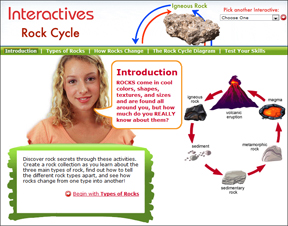
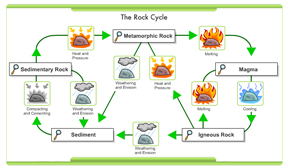
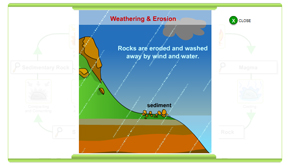
Rock Cycle
This website explains the rock cycle like a self-guided tour dotted with ‘hands-on’ activities. Well-placed animations and explanations help illustrate complex concepts as the student learns the three basic types of rock and how they got that way. The site concludes with a brief quiz to test your newfound knowledge. It asks fifteen thought-provoking, multiple-choice questions and gives instant answers. The quizzes can be printed and are complete with the correct answer, a link to where the information was initially explained, and the coordinating visuals originally presented during the test.
The Adventures of Mineral Man and His Rock Hound
This site€”although a little rough around the edges€”is appealing in that it was designed by elementary school students. Mineral Man and Rock Hound appear on the home page and encourage users to journey with them as they learn rock secrets. Students will get an overview of how rocks are ‘born’, an introduction to geological time and fossils, and a guide to identifying rocks among other things. The home page include links to further resources, word searches, crossword puzzles, a quick vocabulary list, and a field trip narrative and photographs. The text is well written and relevant to upper elementary students. This simple website will inspire your own students to design a comprehensive class website on geology, or any other topic for that matter.
Astro-Venture
This site allows students to choose from one of four different missions (astronomy, atmospheric science, geology, or biology). Throughout the geology mission, the site compares and contrasts Earth with Venus and Mars and poses the age-old question: what is it about Earth that supports life? Students who take a geology mission will choose a role (volcanologist, structural geologist, geomorphologist, or geophysicist), form a hypothesis, analyze data, and decide if Venus or Mars is inhabitable based on their geologic features.
Dynamic Earth
This site has incredible graphics (see above) that really showcase what the Internet can do for understanding science. The animations and easy-to-understand information provide the perfect add-on to classroom lesson plans. This interactive site also offers an assessment that can be scored and printed.
Wicked
There are six very relevant interactives on this site for kids. They include exploring the Earth’s surface, examining plate tectonics, exploring the rock cycle, determining what the earth is made of, playing games to understand heat and pressure, and studying the different spheres inside the Earth.
Additional Resources for Teachers
My Science Box
This website is an incredible resource for science teaching. The particular lesson plan (shown above) is but one example of the high-quality activities found on this site. In this lesson, students will create their own sedimentary layers in plastic cups€”hardly a new concept€”but the difference is in the way this website offers the lesson plan itself. It presents the lesson setup, logistics, background information, play-by-play plan, and then the followup assessment with additional citations of sources and standards. It’s a nice, tidy little package of Lesson.
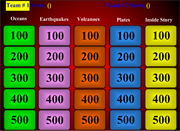 Plate Tectonics Game Show
Plate Tectonics Game Show
by Joe E. Hart
This Jeopardy-style game show is great quizzer, set up to accommodate 2 teams. Questions range from easy (100 points) to more difficult (500 points) in categories like ocean, earthquakes, volcanoes, plates, and ‘inside story’. A big plus is that this game, led by a teacher, alternates questioning between the two teams to alleviate the possibility of one team dominating the game.
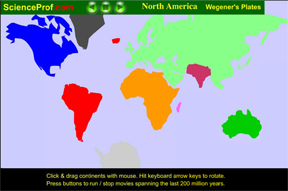 Wegener€”Continental Drift
Wegener€”Continental Drift
This animated resource is the quintessential component on continental drift. Features include cursor rollovers that provide the name of the land masses and a click-and-drag opportunity to put the Pangaea puzzle back together. The website from which this animation was taken also includes a Bullard Fit of Continents animation that depicts the more exact-fit of the continental shelves of Africa, North and South America, and Europe.
Math and Science Innovation Center
Our very own Math and Science Innovation Center is an excellent resource. In the Biology, Earth & Environmental Sciences cluster under The Changing Earth, teachers are provided an entire lesson plan that will either enhance what students have learned during a field trip to the center or offer ideas for engaging students right in the classroom.
Volcano Videos
Volcano Lava
This short video (1:12) shows dramatic footage of pahoehoe and aa lava flows; a good eye-catching way to start a unit on plate tectonics. The soundtrack features appropriate instrumental music that enhances the striking phenomena. You can more videos on volcanoes at the National Geographic Website.
Volcano 101
This video (3:04) features a brief introduction to the creative and destructive nature of volcanoes. Footage includes basic information about volcanoes (e.g., 1500 active around the world with 90 percent in the ring of fire). It also highlights shield versus composite volcanoes explaining the gentle lava flows of one and the dangerous eruptive forces of the latter. It is important to know tht there is a few seconds of footage that shows ash-covered bodies of the Mt. Vesuvius eruption of Pompeii in 79 A.D. All in all, this video would be an excellent unit-summation clip. The narrator speaks very quickly and uses vocabulary that students should know before watching. The video concludes with a brief explanation of how important volcanoes are to us (e.g., created 80 percent of the Earth’s surface and the air we breathe).



